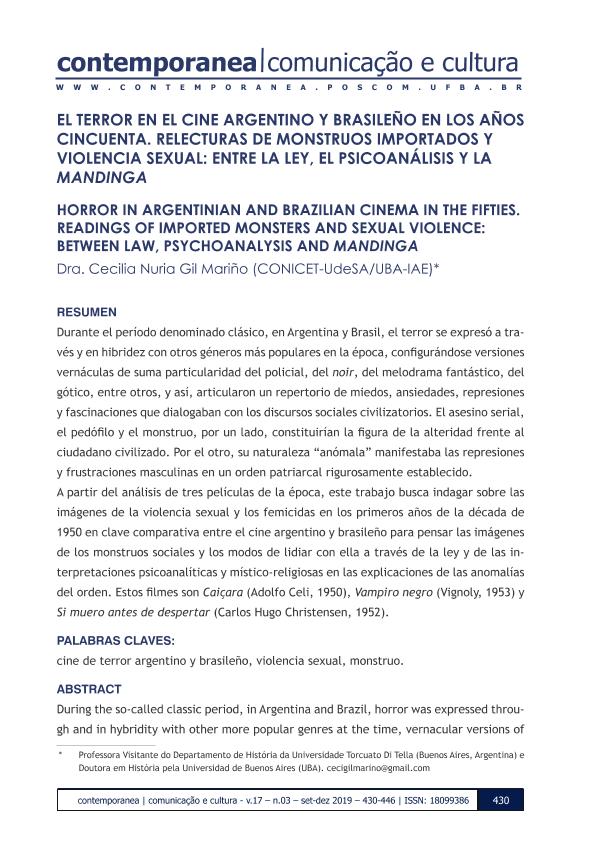Mostrar el registro sencillo del ítem
dc.contributor.author
Gil Mariño, Cecilia Nuria

dc.date.available
2022-06-23T16:06:23Z
dc.date.issued
2019-12
dc.identifier.citation
Gil Mariño, Cecilia Nuria; El terror en el cine argentino y brasileño en los años cincuenta: Relecturas de monstruos importados y violencia sexual. Entre la ley, el psicoanálisis y la mandinga; Universidade Federal da Bahia. Faculdade de Comunicação. Programa de Pós-Graduação em Comunicação e Cultura Contemporâneas; Contemporanea; 17; 3; 12-2019; 430-446
dc.identifier.issn
1809-9386
dc.identifier.uri
http://hdl.handle.net/11336/160351
dc.description.abstract
Durante el período denominado clásico, en Argentina y Brasil, el terror se expresó a través y en hibridez con otros géneros más populares en la época, configurándose versiones vernáculas de suma particularidad del policial, del noir, del melodrama fantástico, del gótico, entre otros, y así, articularon un repertorio de miedos, ansiedades, represiones y fascinaciones que dialogaban con los discursos sociales civilizatorios. El asesino serial, el pedófilo y el monstruo, por un lado, constituirían la figura de la alteridad frente al ciudadano civilizado. Por el otro, su naturaleza “anómala” manifestaba las represiones y frustraciones masculinas en un orden patriarcal rigurosamente establecido. A partir del análisis de tres películas de la época, este trabajo busca indagar sobre las imágenes de la violencia sexual y los femicidas en los primeros años de la década de 1950 en clave comparativa entre el cine argentino y brasileño para pensar las imágenes de los monstruos sociales y los modos de lidiar con ella a través de la ley y de las interpretaciones psicoanalíticas y místico-religiosas en las explicaciones de las anomalías del orden. Estos filmes son Caiçara (Adolfo Celi, 1950), Vampiro negro (Vignoly, 1953) y Si muero antes de despertar (Carlos Hugo Christensen, 1952).
dc.description.abstract
During the so-called classic period, in Argentina and Brazil, horror was expressed through and in hybridity with other more popular genres at the time, vernacular versions of the police, noir, fantastic melodrama, gothic, among others , and so, they articulated a repertoire of fears, anxieties, repressions and fascinations that dialogued with civilizing social discourses. On the one hand, the serial killer, the pedophile and the monster would constitute the figure of otherness against the civilized citizen. On the other, his “anomalous” nature manifested male repressions and frustrations in a rigorously established patriarchal order. From the analysis of three films of the time, this work seeks to investigate the images of sexual violence and femicides in the early fifties in a comparative key between Argentine and Brazilian cinema to think about the images of social monsters and the ways of dealing with them through the law and psychoanalytic and mystical-religious interpretations in the explanations of anomalies of order. These films are Caiçara (Adolfo Celi, 1950), Vampiro negro (Vignoly, 1953) and Si muero antes de despertar (Carlos Hugo Christensen, 1952).
dc.format
application/pdf
dc.language.iso
spa
dc.publisher
Universidade Federal da Bahia. Faculdade de Comunicação. Programa de Pós-Graduação em Comunicação e Cultura Contemporâneas
dc.rights
info:eu-repo/semantics/openAccess
dc.rights.uri
https://creativecommons.org/licenses/by-nc-sa/2.5/ar/
dc.subject
CINE DE TERROR
dc.subject
CINE CLÁSICO
dc.subject
VIOLENCIA SEXUAL
dc.subject
MONSTRUO
dc.subject.classification
Estudios sobre Cine, Radio y Televisión

dc.subject.classification
Arte

dc.subject.classification
HUMANIDADES

dc.title
El terror en el cine argentino y brasileño en los años cincuenta: Relecturas de monstruos importados y violencia sexual. Entre la ley, el psicoanálisis y la mandinga
dc.title
Horror in argentinian and brazilian cinema in the fifties: Readings of imported monsters and sexual violence. Between law, psychoanalysis and mandinga
dc.type
info:eu-repo/semantics/article
dc.type
info:ar-repo/semantics/artículo
dc.type
info:eu-repo/semantics/publishedVersion
dc.date.updated
2022-06-21T18:14:26Z
dc.identifier.eissn
1806-0269
dc.journal.volume
17
dc.journal.number
3
dc.journal.pagination
430-446
dc.journal.pais
Brasil

dc.journal.ciudad
Salvador de Bahia
dc.description.fil
Fil: Gil Mariño, Cecilia Nuria. Consejo Nacional de Investigaciones Científicas y Técnicas; Argentina. Universidad Torcuato Di Tella; Argentina. Universidad de Buenos Aires. Facultad de Filosofía y Letras. Departamento de Artes. Instituto de Artes del Espectaculo; Argentina
dc.journal.title
Contemporanea
dc.relation.alternativeid
info:eu-repo/semantics/altIdentifier/url/https://periodicos.ufba.br/index.php/contemporaneaposcom/article/view/34934
dc.relation.alternativeid
info:eu-repo/semantics/altIdentifier/doi/http://dx.doi.org/10.9771/contemporanea.v17i3.34934
Archivos asociados
